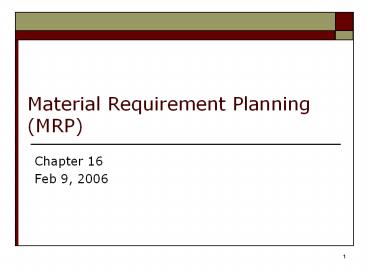Material Requirement Planning (MRP) - PowerPoint PPT Presentation
1 / 21
Title: Material Requirement Planning (MRP)
1
Material Requirement Planning (MRP)
- Chapter 16
- Feb 9, 2006
2
Material Requirement Planning (MRP)
- ______________________________________
- ______________________________________
- Key Outputs of MRP
- Calculate demand for component items
- Determine requirements for subassemblies,
components, and raw material - Determine when they are needed
- Generate work orders and purchase order
- Consider lead time
3
When to use MRP
- ___________________________________
- ___________________________________
- ___________________________________
- ___________________________________
Dependent / Independent Demand?
4
Demand Characteristics
Demand Characteristics for Finished Products and
Their Components
Dependent demand
Independent demand
100 x 1 100 tabletops
100 tables
100 x 4 400 table legs
400 300 200 100
Discrete demand
Continuous demand
400 300 200 100
No. of tables
No. of tables
1 2 3 4 5 Week
M T W Th F M T W Th F
5
MRP Input Output
6
Major Inputs to MRP Process1. Bill of Material
- Product structure file
- Determines which component items need to be
scheduled
7
Major Inputs to MRP Process2. Master Production
Schedule (MPS)
- Drives MRP process with a schedule of finished
products - Quantities represent production not demand
- Quantities may consist of a combination of
customer orders demand forecasts - Quantities represent what needs to be produced,
not what can be produced - Example
PERIOD MPS ITEM 1 2 3 4 5 Clipboard 85 95 1
20 100 100 Lapdesk 0 50 0 50 0 Lapboard 75 120 4
7 20 17 Pencil Case 125 125 125 125 125
8
Major Inputs to MRP Process3. Inventory Record
- _________________________________________________
- Contains an extensive amount of information on
every item that is produced, ordered, or
inventoried in the system - _________________________________________________
DESCRIPTION INVENTORY POLICY
Item Pressboard Lead time 1 Item no. 734 Annual
demand 5000 Item type Purch Holding
cost 1 Product/sales class Comp Ordering/setup
cost 50 Value class B Safety stock
0 Buyer/planner RSR Reorder point 39 Vendor/drawi
ng 07142 EOQ 316 Phantom code N Minimum order
qty 100 Unit price/cost 1.25 Maximum order
qty 500 Pegging Y Multiple order
qty LLC 1 Policy code 3
9
MRP Processes 4 Basic Steps
- Exploding the bill of material
- ___________________________________
- Netting out inventory
- ___________________________________
- ___________________________________
- Lot sizing rule How many units
- ___________________________________
- ___________________________________
- ___________________________________
- Time-phasing requirements
- ___________________________________
10
Lot Sizing Rule Comparison
- The FOQ rule ___________ _______________________
- The POQ rule ___________ _______________________
- _______________________
- _______________________
- The L4L rule ___________ _______________________
- _______________________
- _______________________
11
MRP Matrix
- Gross Requirement
- Derived from planned order releases of the parent
- Actual / estimated demand, in case of final
product - Schedule Receipts
- Items on order
- Scheduled to arrive in the future time period
- Projected on hand
- Current inventory, or anticipated inventory at
the end of period
Inventory on-hand at end of period t - 1
Scheduled / planned receipts in period t
Gross requirements in period t
Projected on-hand Inventory at end of period t
-
12
MRP Matrix
- Net requirements
- Actual quantity to produce based on projected on
hand and on-order quantity - Planned Order Receipts
- Quantity, when orders need to be received
- Consider lot sizing rule
- Planned Order Release
- When order need to be placed to receive on time
- Consider lead time
13
MRP Matrix (You can download the template from
our class webpage)
14
Example MRP Matrix
15
MRP Example 1
- Given the following information, determine when
orders should be released for A, C, and D and the
size of those orders
16
MRP Example 2
- Given the following information, determine when
orders should be released for A, B, C, and D and
the size of those orders.
17
Evolution of MRP
- MRP (material requirements planning) was the
precursor to ERP - Primarily a production planning and control
system - MRP evolved to MRP II (manufacturing resource
planning) - ERP (Enterprise Resource Planning) and ERP II
continue to extend the links through all business
processes
18
Enterprise Resource Planning (ERP)An Overview
- Organizes and manages a companys business
processes by sharing information across
functional areas - Connects with supply-chain and customer
management applications - ERP in the nutshell
- Client server software
- Integrates majority of business processes
- Processes majority of transactions
- Enterprise wide database
- Real time data access
- adapted from e-courseware, MIT Sloan
19
ERP Modules Figure 12.1 Organizational Data
Flow
20
ERP ModulesFigure 12.2 ERPs Central Database
ERP Data Repository
21
ERP Implementation Process
- First step is to analyze business processes
- Which processes have the biggest impact on
customer relations? - Which process would benefit the most from
integration? - Which processes should be standardized?
- Use of Internet portals can aid implementation































